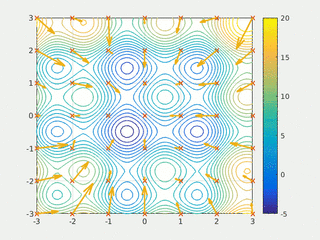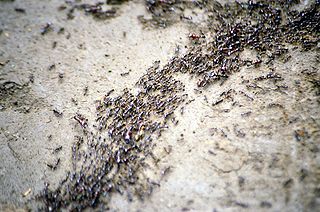
In computer science and operations research, a genetic algorithm (GA) is a metaheuristic inspired by the process of natural selection that belongs to the larger class of evolutionary algorithms (EA). Genetic algorithms are commonly used to generate high-quality solutions to optimization and search problems via biologically inspired operators such as selection, crossover, and mutation. Some examples of GA applications include optimizing decision trees for better performance, solving sudoku puzzles, hyperparameter optimization, and causal inference.

Evolutionary computation from computer science is a family of algorithms for global optimization inspired by biological evolution, and the subfield of artificial intelligence and soft computing studying these algorithms. In technical terms, they are a family of population-based trial and error problem solvers with a metaheuristic or stochastic optimization character.

In computational science, particle swarm optimization (PSO) is a computational method that optimizes a problem by iteratively trying to improve a candidate solution with regard to a given measure of quality. It solves a problem by having a population of candidate solutions, here dubbed particles, and moving these particles around in the search-space according to simple mathematical formulae over the particle's position and velocity. Each particle's movement is influenced by its local best known position, but is also guided toward the best known positions in the search-space, which are updated as better positions are found by other particles. This is expected to move the swarm toward the best solutions.
Tabu search (TS) is a metaheuristic search method employing local search methods used for mathematical optimization. It was created by Fred W. Glover in 1986 and formalized in 1989.

In computer science and operations research, the ant colony optimization algorithm (ACO) is a probabilistic technique for solving computational problems that can be reduced to finding good paths through graphs. Artificial ants represent multi-agent methods inspired by the behavior of real ants. The pheromone-based communication of biological ants is often the predominant paradigm used. Combinations of artificial ants and local search algorithms have become a preferred method for numerous optimization tasks involving some sort of graph, e.g., vehicle routing and internet routing.

Swarm intelligence (SI) is the collective behavior of decentralized, self-organized systems, natural or artificial. The concept is employed in work on artificial intelligence. The expression was introduced by Gerardo Beni and Jing Wang in 1989, in the context of cellular robotic systems.
In computer science and mathematical optimization, a metaheuristic is a higher-level procedure or heuristic designed to find, generate, tune, or select a heuristic that may provide a sufficiently good solution to an optimization problem or a machine learning problem, especially with incomplete or imperfect information or limited computation capacity. Metaheuristics sample a subset of solutions which is otherwise too large to be completely enumerated or otherwise explored. Metaheuristics may make relatively few assumptions about the optimization problem being solved and so may be usable for a variety of problems. Their use is always of interest when exact or other (approximate) methods are not available or are not expedient, either because the calculation time is too long or because, for example, the solution provided is too imprecise.
In machine learning, feature selection is the process of selecting a subset of relevant features for use in model construction. Feature selection techniques are used for several reasons:
The greedy randomized adaptive search procedure is a metaheuristic algorithm commonly applied to combinatorial optimization problems. GRASP typically consists of iterations made up from successive constructions of a greedy randomized solution and subsequent iterative improvements of it through a local search. The greedy randomized solutions are generated by adding elements to the problem's solution set from a list of elements ranked by a greedy function according to the quality of the solution they will achieve. To obtain variability in the candidate set of greedy solutions, well-ranked candidate elements are often placed in a restricted candidate list (RCL), and chosen at random when building up the solution. This kind of greedy randomized construction method is also known as a semi-greedy heuristic, first described in Hart and Shogan (1987).

Differential evolution (DE) is an evolutionary algorithm to optimize a problem by iteratively trying to improve a candidate solution with regard to a given measure of quality. Such methods are commonly known as metaheuristics as they make few or no assumptions about the optimized problem and can search very large spaces of candidate solutions. However, metaheuristics such as DE do not guarantee an optimal solution is ever found.
Parallel metaheuristic is a class of techniques that are capable of reducing both the numerical effort and the run time of a metaheuristic. To this end, concepts and technologies from the field of parallelism in computer science are used to enhance and even completely modify the behavior of existing metaheuristics. Just as it exists a long list of metaheuristics like evolutionary algorithms, particle swarm, ant colony optimization, simulated annealing, etc. it also exists a large set of different techniques strongly or loosely based in these ones, whose behavior encompasses the multiple parallel execution of algorithm components that cooperate in some way to solve a problem on a given parallel hardware platform.
A hyper-heuristic is a heuristic search method that seeks to automate, often by the incorporation of machine learning techniques, the process of selecting, combining, generating or adapting several simpler heuristics to efficiently solve computational search problems. One of the motivations for studying hyper-heuristics is to build systems which can handle classes of problems rather than solving just one problem.
Matheuristics are problem agnostic optimization algorithms that make use of mathematical programming (MP) techniques in order to obtain heuristic solutions. Problem-dependent elements are included only within the lower-level mathematic programming, local search or constructive components. An essential feature is the exploitation in some part of the algorithms of features derived from the mathematical model of the problems of interest, thus the definition "model-based heuristics" appearing in the title of some events of the conference series dedicated to matheuristics matheuristics web page.
In operations research, cuckoo search is an optimization algorithm developed by Xin-She Yang and Suash Deb in 2009. It has been shown to be a special case of the well-known -evolution strategy. It was inspired by the obligate brood parasitism of some cuckoo species by laying their eggs in the nests of host birds of other species. Some host birds can engage direct conflict with the intruding cuckoos. For example, if a host bird discovers the eggs are not their own, it will either throw these alien eggs away or simply abandon its nest and build a new nest elsewhere. Some cuckoo species such as the New World brood-parasitic Tapera have evolved in such a way that female parasitic cuckoos are often very specialized in the mimicry in colors and pattern of the eggs of a few chosen host species. Cuckoo search idealized such breeding behavior, and thus can be applied for various optimization problems.
The Bat algorithm is a metaheuristic algorithm for global optimization. It was inspired by the echolocation behaviour of microbats, with varying pulse rates of emission and loudness. The Bat algorithm was developed by Xin-She Yang in 2010.

Enrique Alba is a professor of computer science at the University of Málaga, Spain.

EWG EU/ME, the EURO Working Group on Metaheuristics, formerly referred to as EU/ME – the metaheuristics community, is a working group the main purpose of which is to provide a platform for communication among researchers in the field of metaheuristic optimization, practitioners interested in applying metaheuristic optimization techniques in practice, developers of optimization software, and the general public.
In evolutionary computation, Minimum Population Search (MPS) is a computational method that optimizes a problem by iteratively trying to improve a set of candidate solutions with regard to a given measure of quality. It solves a problem by evolving a small population of candidate solutions by means of relatively simple arithmetical operations.






